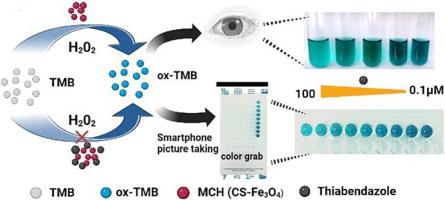Sensing and Bio-Sensing Research Pub Date : 2023-10-18 , DOI: 10.1016/j.sbsr.2023.100595 Abera Merga Ariti , Seada Abdo Geleto , Beamlak Teshome Gutema , Efrata Getachew Mekonnen , Yitayal Admassu Workie , Ebrahim M. Abda , Menbere Leul Mekonnen

|
Although nanozymes proved a promising utility in sensing applications, they often lack a rational approach in their design. Herein, magnetite chitosan hydrogel (MCH) is reported as a rational peroxidase nanozyme for the smartphone-assisted colorimetric detection of thiabendazole (TBZ). Chitosan due to its polycationic nature, renders a microenvironment similar to amino acids in HRP enzyme. Characterizations of the nanozyme using SEM, XRD, and XPS confirmed the distribution of Fe3O4NPs on the chitosan matrix. The peroxidase activity was demonstrated using TMB and H2O2 as substrates which resulted in a characteristic absorption at 652 nm. MCH nanozyme showed a 24% higher peroxidase activity in acidic pH than the pristine Fe3O4 confirming the role of chitosan in boosting the electron transfer. Kinetics result suggested the catalytic reaction followed a Michalis-Menten model with Km and Vmax of 0.45 mM and 15 μM/min for TMB and 2.8 mM and 4.18 μM/min for H2O2 respectively. These values are competitive with natural HRP enzymes reported before. Further, MCH nanozyme showed improved thermal and temporal stability as well as reusability retaining 80% of its activity after the 4th cycle. TBZ showed concentration-dependent inhibition on the peroxidase activity. The degree of inhibition exhibited a linear relationship with the concentration of TBZ from 0.1 to 100 μM (R2 = 0.998) enabling the detection of TBZ down to 0.73 and 1.84 μM in a spectrometer and smartphone-based readouts respectively. The results show the potential of the prepared nanozyme as a point-of-need sensor for food safety monitoring.
中文翻译:

具有内在过氧化物酶活性的磁铁矿壳聚糖水凝胶纳米酶用于智能手机辅助噻菌灵比色传感
尽管纳米酶在传感应用中被证明具有广阔的应用前景,但它们在设计中往往缺乏合理的方法。在此,磁铁矿壳聚糖水凝胶(MCH)被报道为一种合理的过氧化物酶纳米酶,用于智能手机辅助比色检测噻菌灵(TBZ)。壳聚糖由于其聚阳离子性质,可提供类似于 HRP 酶中氨基酸的微环境。使用 SEM、XRD 和 XPS 对纳米酶进行表征,证实了 Fe 3 O 4纳米颗粒在壳聚糖基质上的分布。使用 TMB 和 H 2 O 2作为底物证明了过氧化物酶活性,导致 652 nm 处的特征吸收。MCH 纳米酶在酸性 pH 条件下表现出比原始 Fe 3 O 4高 24% 的过氧化物酶活性,证实了壳聚糖在促进电子转移方面的作用。动力学结果表明催化反应遵循Michalis-Menten模型,TMB的K m和V max分别为0.45 mM和15 μM/min,H 2 O 2的K m 和V max 分别为2.8 mM和4.18 μM/min 。这些值与之前报道的天然 HRP 酶具有竞争力。此外,MCH 纳米酶表现出改善的热稳定性和时间稳定性以及可重复使用性,在第四次循环后仍保留 80% 的活性。TBZ 对过氧化物酶活性表现出浓度依赖性抑制。抑制程度与 TBZ 浓度在 0.1 至 100 μM 范围内呈线性关系 (R 2 = 0.998),从而能够在光谱仪和基于智能手机的读数中分别检测低至 0.73 和 1.84 μM 的 TBZ。结果表明所制备的纳米酶作为食品安全监测的需求点传感器的潜力。



























 京公网安备 11010802027423号
京公网安备 11010802027423号